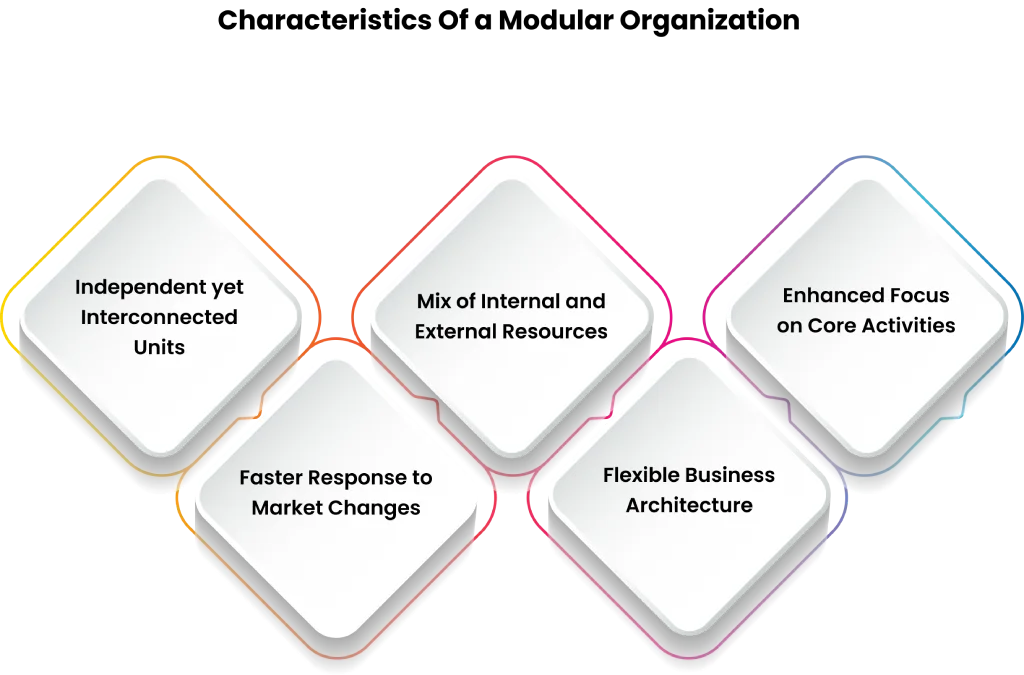Home / M / Modular Organization
Modular Organization: Meaning, Benefits, Examples, and How to Improve
Modular organizations are redefining how companies operate today. Instead of demanding that everything be done under one roof, modular organizations partition work into small and more manageable parts referred to as "modules." Each module can either be produced or performed internally in-house by the host company, or it can be produced by a specialist vendor located outside of the company. This flexible organizational structure allows the organization to take chances, explore new markets, remain competitive, manage resources, and enable growth.
The beauty of this structure is its simplicity: If a company wants to grow, it may simply add modules or amend existing modules. If an organization has decided to slow down the organization can reduce the number of modules produced or increase the number of modules produced by external vendors. The modular organizational structure allows firms to reduce time to market, provides opportunities to reduce costs, increases innovative capabilities, and better positions organizations in a rapidly changing market.
What is Modular Organization?

Modular organization refers to an organizational structure in which units or teams are independent but linked together through a common system. These units can include contracted service providers or departments designed for specific purposes to support the business.
Understanding Modular Organizations
A modular organization is similar to a puzzle with varying sizes of pieces. Each piece (or module) is responsible for a specific business function (customer support, logistics, and marketing). Some of the modules may be the internal end product of the organization, and some may be purchased from outside third-party vendors.
Importance of Modular Organizations
This organizational type is important for organizations looking to maintain flexibility in their business architecture. Rather than being dependent on large internal teams, companies will have the ability to select effective partnerships to fulfil specific functions. It can result in tremendous time savings, decreased costs, and added value when seeking expert assistance.
Greater Flexibility and Focus
By relying on a modular type of system, the organization will be able to react more quickly to market demands. For example, if there is a sudden demand for increased production, only the module for production needs to make changes within its system, not the whole organization. This will provide the units with a greater sense of autonomy and visibility into what they are doing.
Encourages Innovation
Since different modules can work with external partners or adopt new technologies, it becomes easier for the organization to bring in fresh ideas. Innovation flows faster because each module has the freedom to try new things while still aligning with the core business goal.
What Are Some Examples of Modular Organizations?

Many successful companies adopt a modular structure to remain innovative and relevant, while global companies leverage it to remain nimble and competitive.
- Toyota – Designs and assembles cars yet fabricates key parts through various suppliers who are responsible for parts like the engine or the electronics.
- IKEA – Designs furniture but contracts production to global suppliers; the customers assemble it, thus even more modular.
- Software Companies – Typically have core teams who develop products and support, and payroll and IT are sourced through specialists.
- Manufacturing – Many automotive and technology companies utilize modular to focus on design and assembly, while partners fabricate key components.
- Nike – Designs products but contracts the manufacturing to pursue brand and innovative design.
- Apple – Designs and develops in-house but procures components from suppliers.
- Dell – Sources and builds custom computers utilizing vendors and partners.
- Unilever – Manages its global supply chain with multiple independent service providers.
These companies control a strategy at the centre while allowing disparate parts of the business to operate independently or moderating their independence. This provides the ability to gain the advantage they seek but maintain some measure of control over the brand.
How to Build a Modular Organization?
1. Identify Core Competencies
Determine those activities that your business needs to do in-house, such as product design or customer experience. Everything else is ancillary to your core areas of strength that define you as a brand.
2. Determine What Not to Do
Once you have assessed your core competencies, you can review other important functions, but not core to your identity, such as payroll, logistics, and anything related to IT services. The labour-intensive tasks can be outsourced to more focused third-party partners.
3. Choose Good Partners
You will benefit from solid partnerships by working with trustworthy service providers who are aligned in understanding your goals. As much as possible, good communication and good values will make sure that the modules fit well together.
4. Put Infrastructure in Place to Enable Clarity of Communication
Even though modular functions operate independently from one another, it is important to keep them connected. Leverage the power of project management software or systems, which will create consistency across the board and ensure people are aligned and information flows freely from module to module.
5. Set Measurements of Performance
Measure the performance of each of the modules not just by time, but with their company-wide, team-based specific goals in mind. Ensure everyone is clear about what success means and how performance will be assessed.
6. Be Prepared to Change Modules
Part of the benefit of modularity is the ability to be flexible. If one of your modules ends up leaking value on your performance scorecard, or if your business strategy changes, simply remove/remodel, or replace that module with little, if any, hangover impact.
What Are the Advantages of Modular Organization?
- Flexibility: Also, can be scaled up or down, can add and/or remove modules, as desired
- Cost Savings: Employing an outside provider to take over non-core tasks saves overall money related to operations and overhead
- Innovation: Teams and partners innovate and foster more new ideas because they work in their areas of expertise
- Speed: Can quickly respond to market changes since any change only affects specific modules
- Learning: Employees can see how various parts of the company work together, transferring collective knowledge
What Are the Disadvantages of a Modular Organization?
- Coordination Problems: If the communication is poor, modules may lose synchrony.
- Loss of Control: Outsourcing pays little regard to direct supervision regarding its function.
- Reliance on Outside Foundations: Relying on too many outside partners can be risky; the continued reliance on various outside partners increases risk.
- Quality Differences: Different modules based on the location may have differences in standards.
- Cultural Dislocations: External teams often need a dedicated leader to fully understand the company's culture and vision.
How Does a Modular Organization Differ from a Hollow Organization?
A hollow organization simply gives away whole functions (for example, production or HR) and essentially keeps only its core functions internal. In contrast, a modular organization does not allow you the distribution of work by function or by pre-determined logical organizational boundaries. Rather, it imports and integrates parts into goods that are produced and services that are generated. This organization breaks unit work into manageable modules that can be managed, substituted, or manipulated independently, and all can be integrated centrally as a complete bundle.
Typically both these organizations employ outsourcing , but in a hollow organization the organization has less control as the organization decides on the functions of the production and processes carried out by more than one company, and even less control if there is further distribution and movement for the final product or service than the organization imagined - meanwhile a modular organization controls more of how those parts work cohesively together.
Simply, a modular organization holds onto and incorporates its most fundamental parts internally while giving away the rest of its processes, functions, and roles to others. Comparatively, a hollow organization is like a shell with very little inside and largely depends on other organizations doing the actual work.

